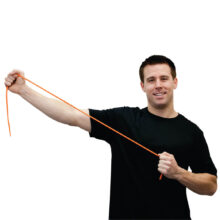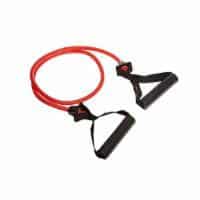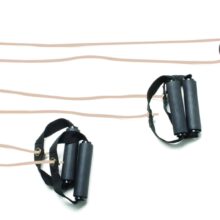Active Recovery Kit
Login For Dealer Pricing
The latex free Theraband Active Recovery Workout Kit is ideal for upper and lower body exercise for strengthening muscles, increasing your range of motion and improving your flexibility.
Resistance tubing, a similar but different product than exercise bands or resistance bands, has become a widely used and versatile tool in sports medicine. With its ability to provide progressive resistance and target specific muscle groups, resistance tubing offers numerous benefits for athletes and sports medicine professionals.
From strength training and rehabilitation to injury prevention and performance enhancement, resistance tubing plays a crucial role in optimizing athletic performance.
In this article, we will explore the significance of resistance tubing (sometimes referred to as resistance tubes) in sports medicine and delve into its applications and advantages for athletes.
Resistance tubing is a valuable tool for strength training and muscle activation in sports medicine. Athletes can perform a wide range of resistance exercises, such as bicep curls, rows, shoulder presses, and squats, using the bands to provide varying degrees of resistance. These exercises target specific muscle groups and help athletes develop strength, power, and muscular endurance. Resistance tubing also allows for multi-planar movements, closely simulating the functional demands of sports activities.
Resistance tubing plays a critical role in the rehabilitation process for athletes recovering from injuries or undergoing post-operative rehabilitation. The bands offer a low-impact and controlled method of resistance that allows athletes to gradually rebuild strength, range of motion, and joint stability. Resistance tubing is commonly used in sports medicine to rehabilitate various injuries, including those involving the shoulders, hips, knees, and ankles. It helps athletes regain functional strength, stability, and neuromuscular control, reducing the risk of re-injury and promoting a safe return to sports activities.
Maintaining flexibility and mobility is essential for optimal athletic performance and injury prevention. Resistance tubing can be utilized to improve flexibility and joint mobility in a targeted manner. Athletes can perform stretching and mobility exercises, such as shoulder rotations, leg swings, or hip abductions. The tubing provides resistance during these exercises, increasing the challenge and intensity while improving joint range of motion, muscle elasticity, and overall flexibility.
A strong and stable core is fundamental for athletic performance and injury prevention. Resistance tubing can be effectively used to target the muscles of the core, including the abdominals, obliques, and lower back. Athletes can perform exercises like standing rotations, plank variations, or seated rows using the bands to engage and strengthen their core muscles. These exercises improve core stability, balance, and posture, enabling athletes to generate and transfer forces effectively, while reducing the risk of imbalances or compensatory movements.
One of the advantages of resistance tubing is its portability and convenience. The bands are lightweight, compact, and easily transportable, making them a practical tool for athletes on the go. Athletes can incorporate resistance tubing into their training routines, warm-up sessions, or rehabilitation programs, whether they are at home, on the field, or traveling. The versatility and accessibility of resistance tubing allow athletes to maintain their strength, flexibility, and conditioning wherever they are, without the need for extensive equipment.
Resistance tubing offers progressive resistance, allowing athletes to gradually increase the challenge as they improve their strength and conditioning. The bands come in different levels of resistance, from light to heavy, providing athletes with options to match their current fitness level and training goals. Resistance tubing is adaptable to various exercises and can be easily modified to target specific muscle groups or accommodate different movement patterns, making it suitable for athletes of all levels and sports disciplines.
It is important not to confuse these very similar (but distinct) pieces of exercise equipment. We explain the differences in design and construction below.
Resistance tubing, also known as exercise tubes or resistance cords, is typically made of latex or rubber. It features a long, flexible tube with handles on each end. The tubing is available in various levels of resistance, typically identified by different colors. Some resistance tubing comes with detachable handles or interchangeable attachments to allow for different exercises and grip options.
Resistance bands are flat, wide strips of elastic material, commonly made of latex or latex-free materials. They are available in various lengths and resistance levels, indicated by color or thickness. Resistance bands can be either open-looped (without handles) or closed-looped (forming a continuous loop). Closed-loop bands are typically used for lower body exercises, while open-loop bands offer more versatility for upper body and full-body workouts.
Resistance tubing has become an invaluable tool in sports medicine, supporting athletes in strength training, rehabilitation, injury prevention, and performance enhancement. From targeted muscle activation to promoting flexibility, core stability, and balance, resistance tubing provides athletes with a versatile and effective means of conditioning their bodies and optimizing their athletic performance. Its portability, progressive resistance, and adaptability make resistance tubing a practical and essential component of sports medicine programs aimed at improving athletic abilities and promoting overall well-being.

Login For Dealer Pricing
The latex free Theraband Active Recovery Workout Kit is ideal for upper and lower body exercise for strengthening muscles, increasing your range of motion and improving your flexibility.

Login For Dealer Pricing
Band & Tubing Scissors are an important accessory for cutting exercise band and tubing down to the correct size.

Login For Dealer Pricing
An adjustable strap that attaches to Exercise Bungee Cords.

Login For Dealer Pricing
This exercise bungee cord is useful for either upper or lower body exercises and has a snap-hook on one end and a door jamb nub and a loop anchor on the other end.

Login For Dealer Pricing
360 Athletics Figure 8 Resistance Tubing offers a convenient way to take your exercise equipment along with you on the road and can be used at times that fit with your schedule to keep you in peak physical condition at all times.

Login For Dealer Pricing
The CanDo® Jelly Expander is great for upper body exercises. The gel-type stretch exerciser is available in 3 configurations with 3 color-coded resistances for each configuration.

Login For Dealer Pricing
High quality Low Powder Exercise Tubing Rolls that are easily portable to work, the cottage or on vacation.Progressive colour coding using distinctive and attractive colours.

Login For Dealer Pricing
Cando’s Over Door Exercise Bar & Tubing allows you to perform interesting and varied workouts right in the comfort of your own home.

Login For Dealer Pricing
Theraband Resistance Tubing is an excellent accessory for toning and strengthening both upper and lower body muscles and reversing muscle atrophy after an injury.

Login For Dealer Pricing
360 Athletics Resistance Tubing with Handles provide a convenient way to exercise and strengthen muscles in the upper and lower body and are equipped with large easy to grip handles that are simple to slip over your feet and ankles for more effective workouts.

Login For Dealer Pricing
Lightweight, compact and portable, the tubing exerciser helps perform strengthening and conditioning workouts on-the-go, even in your hotel room! Two permanent foam covered rigid handles give the exerciser comfort and a firm grasp. CanDo® is licensed to use the Thera-Band® color sequence so resistance level is easily identified. The BowTie exerciser is available in 7…

Login For Dealer Pricing
Lightweight, compact and portable, the tubing exerciser helps perform strengthening and conditioning workouts on-the-go, even in your hotel room! Two permanent foam covered rigid handles give the exerciser comfort and a firm grasp. CanDo® is licensed to use the Thera-Band® color sequence so resistance level is easily identified. The tubing with handles exerciser is available…